SPAIN
Valencia

Valencia
Valencia
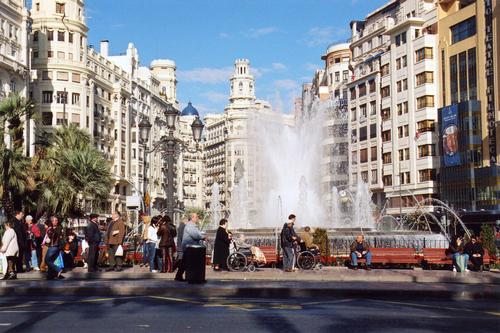 ValenciaPhoto: Adelheid Bischoff CC 3.0 Unported no changes made
ValenciaPhoto: Adelheid Bischoff CC 3.0 Unported no changes made
Valencia is the third city in all of Spain, it is a very progressive city, with spectacular architecture, both old and new. In recent years, Valencia has tried to reinvent itself and succeeded at all levels. The beautiful City of Arts and Sciences (Ciudad de las Artes y las Ciencias) has quickly become the city's biggest tourist attraction.
Valencia is also known for its beautiful climate, the vast region of Valencia has some beautiful sandy beaches and more than 500 km of attractive coastline. The city of Valencia is famous for its paella, with many excellent restaurants and good food in the city, including a range of tapas bars in the old quarter, around the Plaza de la Reina.
Location
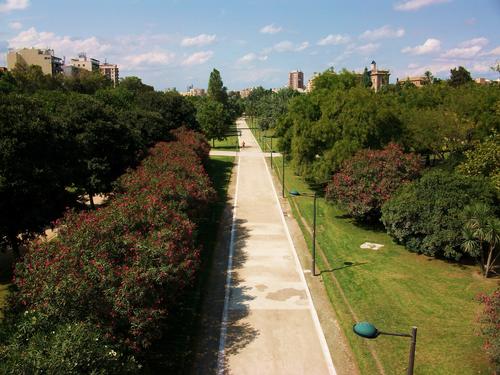 Valencia Turia ParkPhoto: Joanbanjo CC 3.0 Unported no changes made
Valencia Turia ParkPhoto: Joanbanjo CC 3.0 Unported no changes made
Valencia is located on the east coast of Spain, on the Costa del Azahar. It is a sizeable Spanish city, with a population of around one million. Much of life in Valencia takes place in the area of the former Turia River, which was diverted south after a severe flood in 1957. The dry riverbed was soon turned into a lush urban park. The old part within the old city walls has a characteristic oval shape and here are the three large public squares, the Plaza del Ayuntamiento, the Plaza de la Reina and the Plaza de la Virgen
Weather
Valencia has a Mediterranean climate, with hot, dry summer weather and mild winter months. The temperatures in Valencia are very pleasant all year round and remain well above freezing even in winter. With nearly 3,000 hours of sunshine a year, which is around eight hours of sunshine a day on average, Valencia is known for its beautiful weather and attractive climate. Valencia is located in the heart of Spain's east coast and its white sandy beaches are very popular in the summer season.
Spring starts early in Valencia and is the perfect time to visit the city, the climate is generally quite mild, especially along the coastline. Rainy weather is more common during spring, with occasional heavy showers. But the sun is never far away. The average temperature in February is around 16°C and by the end of March it is usually beach weather and it is warm enough for shorts and T-shirts during the day.
In summer it is hot in Valencia, with daytime temperatures around 28°C. In July and August the temperature rises often above 30°C. Summer is the high season in Valencia and the city becomes a major tourist destination, with visitors taking advantage of the sunny weather and the beautiful sandy beaches along the coast. The sea water of the Mediterranean can reach 25°C, ideal for a refreshing dip.
Autumn is still a good time to visit the area, with mild temperatures and many sunny days. Temperatures in Valencia average around 25°C in September and around 19°C in late October / early November. November, December and January are the coldes months in Valencia, although the temperatures are generally well above 10°C and the sea water has an average temperature of about 13°C.
History
The city of Valencia has a rich history thanks to the influences of the Roman, Arab and Christian powers that have ruled the city for long periods. The historic center of Valencia is one of the largest in Spain and its ancient monuments and cultural attractions draw millions of visitors every year. Nevertheless, this vibrant city also has a modern look and is one of the busiest commercial ports in Europe.
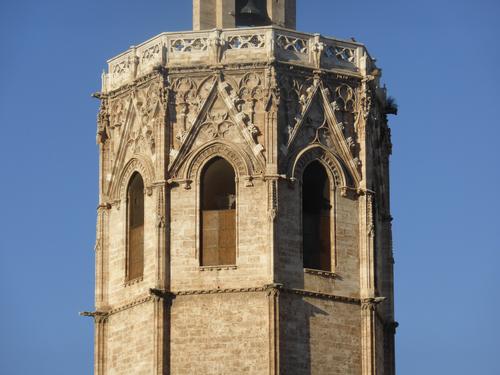 Valencia El Micalet TowerPhoto: Carlos Teixidor Cardenas CC 3.0 Unported no changes made
Valencia El Micalet TowerPhoto: Carlos Teixidor Cardenas CC 3.0 Unported no changes made
The history of Valencia begins with the Romans, who founded the city of Valentia in the year of 138 BC on the site of ancient Greek and Phoenician settlements. In the centuries that followed, Visigoths, Byzantines and eventually Arabs ruled this coveted port on the Mediterranean. The Arab Moors who ruled this place for 500 years from the 8th century had a great impact on the city. The Moors introduced an important irrigation system to the area that allowed the cultivation of olives, rice and the famous oranges. The Arab heritage can still be admired in the remains of the old city towers around Portal de Valldigna street, the Banos del Almirante bathhouse and the El Micalet tower.
The history of Valencia contains a unique chapter in the struggle between the Christians and the Moors. The infamous Castilian military commander and nobleman El Cid, who wanted his own Christian fief, besieged Valencia in the latter part of the 11th century. After two years he took the city and ruled for five years from 1094 until he was assassinated while defending the city from the Moors. The epic poem 'The Song of El Cid' tells this story.
In 1238, King Jaime I of Aragon conquered Valencia and forced the Moors to surrender. This marked the end of a glorious era. About 50,000 Moors were exiled, including the legendary poet and diplomat Ibn al-Abbar. Jaime I founded the Kingdom of Valencia and allowed the remaining Jews, Christians and Muslims to stay. This tolerant approach has allowed the city to maintain its rich cultural diversity.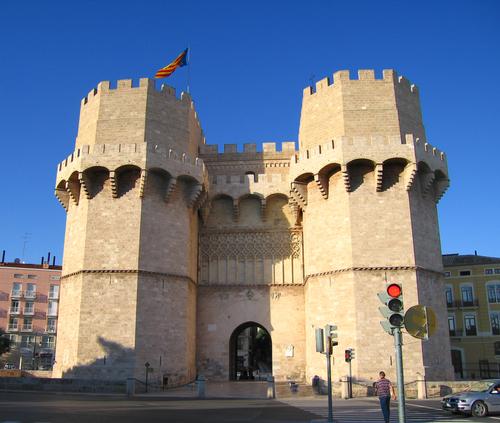 Valencia Serrano TowersPhoto: Felivet in the public domain
Valencia Serrano TowersPhoto: Felivet in the public domain
The 15th century is known as the Golden Age of Valencia, a period when art and culture flourished in the city. The commercial success of the city brought a revival in the artistic and cultural activities. The history of Valencia was manifested in this period through the construction of the Serrano Towers (Torres de Serrano) in the late 14th century. Textile production and trade fueled the local economy, as did the funding of Christopher Columbus's famous expedition in 1492 and the construction of the Silk Exchange, now a UNESCO World Heritage Site. During the 16th century, Valencia was one of the most influential cities on the Mediterranean.
After the Golden Age, a decline came. The 17th century began with the expulsion of Jews and Moriscos (Moors who had converted to Christianity). This forced eviction caused a decrease of more than 30 percent of the population of Valencia, which was a blow to the economy. The decline peaked during the 1702 War of the Spanish Succession, when Valencia sided with the losing side. The city was occupied by English troops and then sacked by the French army.
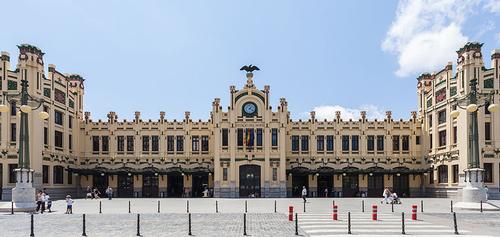 Valencia North StationPhoto: Diego Delso CC 4.0 International no changes made
Valencia North StationPhoto: Diego Delso CC 4.0 International no changes made
De 19e eeuw was Valencia beter gezind, er ontstond een beweging om het erfgoed van de Catalaanse taal en regionale tradities te herstellen. Lokale trots versterkte ook de economie en de stad werd weer een industriële grootmacht aan het begin van de 20e eeuw. Het Art Nouveaux Noordstation en de centrale markt zijn het levende bewijs van de opbloei van Valencia.
Franco's dictatorship slowed the growth and rediscovery of Valencia's Catalan roots, but after Franco's death, the city regained its prosperity. Now the city is known for both its industry and its rich cultural offerings such as the museums, the historic old town and the modern City of Arts and Sciences.
Sights
Valencia is full of historical sites and monuments, including many great palaces, old stone bridges and a beautiful Town Hall (Ayuntamiento). The city also boasts some ancient Roman remains, with some important treasures unearthed around the Plaza de la Almoina. Other important sights include the historic wall that once surrounded almost the entire city, an imposing Plaza de Toros, the Lonja building, the World Heritage Stock Exchange and of course the City of Arts and Sciences.
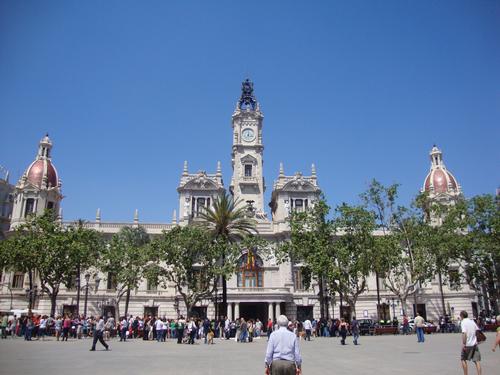 Valencia AyutamientoPhoto: El fosilmaníaco CC 3.0 Unported no changes made
Valencia AyutamientoPhoto: El fosilmaníaco CC 3.0 Unported no changes made
More a palace than a Town Hall, the Ayuntamiento is located on Plaza del Ayuntamiento, the city's largest square. Dating back to the 18th century, both the exterior and interior of the building are grand, some of the main attractions are a museum and a grand ballroom, where important receptions are regularly held. There are many good bars, restaurants, shops and a popular cinema in the area. The Ayuntamiento de Valencia is where the Mascleta fireworks are held during the Fallas festival.
Located in the old quarter, the Plaza de la Almoina is an imposing square and a remarkable archaeological treasury, where many of the most important artifacts have been excavated, including Roman remains. An archaeological site is located nearby, on the San Vincente Martir and offers a wealth of information about this square, its history and the jewels of the past uncovered.
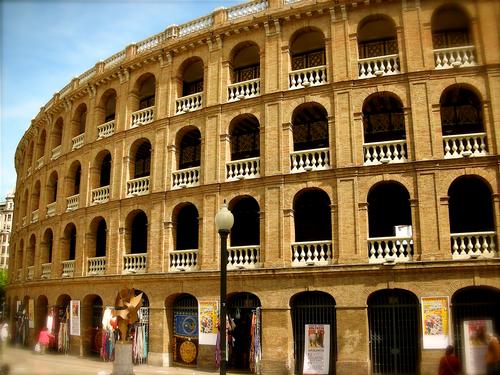 Valencia Plaza de TorosPhoto: Enrique Dans CC 2.0 Generic no changes made
Valencia Plaza de TorosPhoto: Enrique Dans CC 2.0 Generic no changes made
The Plaza de Toros is a particularly large and imposing arena, built in the mid-19th century, with a truly spectacular architecture. Whatever your opinion of bullfighting, this venue is well worth a visit if only to appreciate the craftsmanship and tremendous attention to detail.
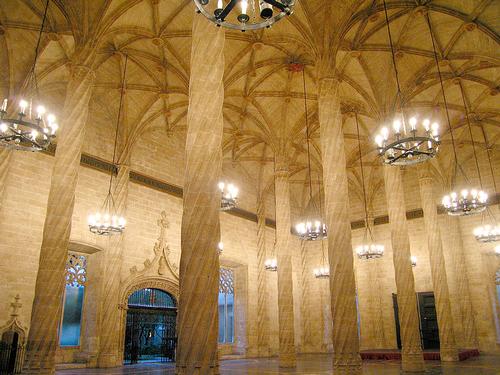 Valencia lonjaPhoto: Felivet in the public domain
Valencia lonjaPhoto: Felivet in the public domain
One of the most eye-catching monuments in the old quarter of Valencia, the Lonja building has been awarded the prestigious World Heritage title. Located on the busy Plaza del Mercado, it dates back to the late 13th century and is the fair of great historical significance. The popular market, a central garden and the detailed architecture are the main attraction in and around the Lonja.
Tips
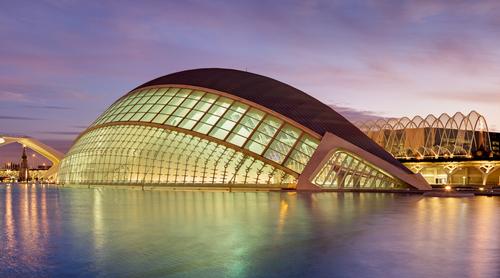 Valencia City of the Arts and SciencesPhoto: David Iliff CC 3.0 Unported no changes made
Valencia City of the Arts and SciencesPhoto: David Iliff CC 3.0 Unported no changes made
Without a doubt, Valencia's most notable attraction is the City of Arts and Sciences, known locally as the City of Artes and Ciencias. This sprawling complex features numerous futuristic buildings and consists of four major tourist attractions, the Planetarium, the Reina Sofia Opera House, the Oceanographic Park and the Prince Felipe Science Museum. The city is designed by Santiago Calatrava and Félix Candela.
The Planetarium is one of the city's most popular tourist attractions and features a modern cinema and a planetarium. There are scientific exhibits, space related showcases and you can get a lot of astronomical information. The Planetarium is housed in a particularly stylish building, and represents the contemporary architecture at its best.
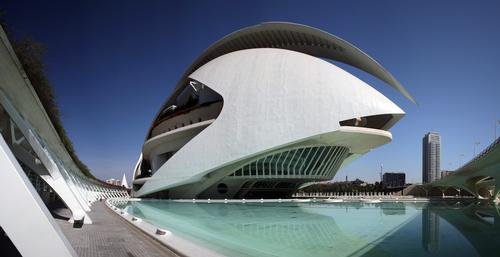 Valencia Palacio de las Artes Reina SofiaPhoto: Zibi CC 3.0 Unported no changes made
Valencia Palacio de las Artes Reina SofiaPhoto: Zibi CC 3.0 Unported no changes made
An impressive modern building is the Palacio de las Artes Reina Sofia. This center actively promotes local art and culture. It features a beautiful, modern façade and regularly hosts theater performances, operas and concerts. The Palacio de las Artes includes a main hall, amphitheater and the Camera Theater.
The Parque Oceanográfico is part of the famous 'City of Arts and Sciences' and is located in the Quatre Carreres district. Particularly popular with families, this major attraction plays an important role in protecting the marine environment and includes Beluga whales, penguins, walruses and tropical fish, and popular dolphin shows.
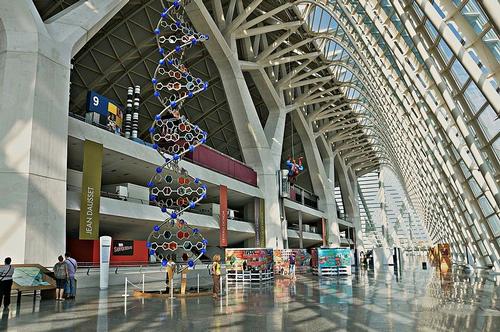 Valencia Prince Felipe Science CenterPhoto: Alberto-g-rovi CC 3.0 Unported no changes made
Valencia Prince Felipe Science CenterPhoto: Alberto-g-rovi CC 3.0 Unported no changes made
The Prince Felipe Science Museum is a huge museum in an equally impressive building. It shows scientific discoveries and theories of both the past and the present. The museum is full of modern technology. The museum was designed by Santiago Calatrava, a renowned architect. There you can do workshops and see theater performances. The museum has a 'Space Academy' and many display cases.
Useful links Valencia
BBC Country ProfilesWorld Fact Book Explore all Countries
How to call
Last updated November 2025
Copyright: Team - The World of Info